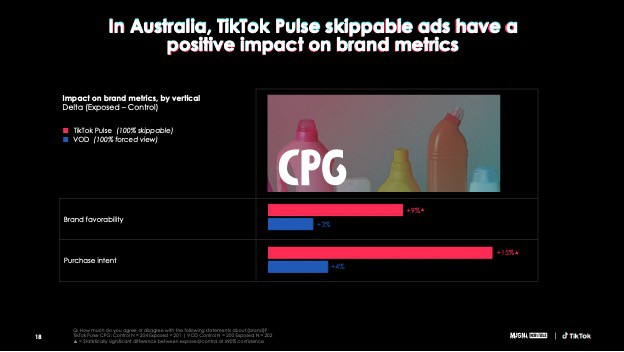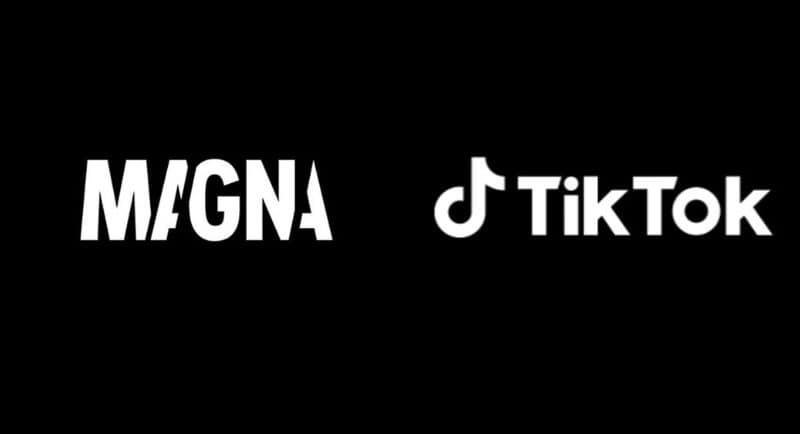Giving audiences more control through skippable ads increased purchase intent by 15% for FMCG and positively impacted recommendation by +8%, a recent study on TikTok has found.
The findings from Magna, the investment and intelligence arm of IPG Mediabrands, in partnership with the short-form video platform, revealed the choice to watch ads creates a more lasting impression the longer viewers choose to watch (+38% lift in unaided ad recall when 50-100% of the ad is watched).
More than 12,000 people participated in the “Revisiting the Inner Workings of Digital Video” study across Australia, the USA, UK, Canada, Germany, and France. The study on TikTok examined ad content for 36 brands across Media & Entertainment, Retail, and FMCG categories.
The results revealed that consumers engaging with TikTok content are 21% more likely to feel excitement, which “inspires greater audience engagement” than other online video platforms.
The research explored the kinds of content that inspire audiences to tune in and stay engaged. It also examined why brands should want their ads on mobile entertainment apps right next to the content and to empower consumer choice when navigating the video platform.

Hannah Rook
Hannah Rook, Magna’s head of intelligence and insights, told Mediaweek that empowering consumers to skip video content at any time and engage with advertising content that resonates can positively impact their “openness” to consuming advertising.
“Ad receptivity is an area Mediabrands has been proactively exploring, making efforts to measure and adopt into our planning practices, forming part of our impact quality methodology,” she said.
However, Rook noted that considering a consumer platform expectation alongside these findings was important.
“For example, when content is in short form, ‘stacked’ and watched in quick succession, then ‘skippable’ experiences are crucial to help platform engagement. In cases of a sit-back viewing experience with long-form content and differing levels of ad load, user expectations & tolerance to advertising can differ. Therefore, the broad conclusion of skippable consistently performing better than forced-view cannot be made from this study.”

In this study, Rook noted that consumers were asked about their perception of the skippable and forced ad experiences.
She said the report found that 74% of Australians surveyed agreed that “having the ability to skip makes me more engaged in the experience.” In comparison, 59% of Australians also stated that they are “more likely to watch videos sponsored by brands when they have the option to skip”.
Rook also said the research findings uncovered that viewers who chose to engage in “skippable” creative (reaching 50-100% completion rate of the video) went on to perform higher on ad recall by +38% when compared to forced view Video on Demand (in player) at +30%.
The study also found that marketers can achieve better results with viewers by going beyond high-quality content and getting ad adjacency next to enjoyable, relevant, “Hot” content on platforms where their desired audiences naturally engage.

As a strategy, the data revealed that contextual ad adjacency and products like TikTok Pulse, the platform’s content targeting, led to a substantial impact on brand favourability (+11%), search intent (+17%), and purchase intent (+15%).
The findings from the study also revealed that full skippable ads only need to be ¼ of the viewing time on a platform like TikTok, compared to VOD, to impact key brand metrics. According to the report, brands could see better results through contextual ad adjacency with in-market potential new customers and need less time to win their hearts, minds, and wallets.
Rook said that to achieve the best brand placement, media partners and agencies must work closely together in adjacency selection.
To achieve contextual ad adjacency, she noted that it was essential for the media owner to have the ability to offer contextual targeting capabilities to the advertiser or have the option to use a third-party technology provider compatible with the platform to deploy the targeting.
She noted that understanding a “brand’s suitability profile” and what environments are best placed to carry an individual client’s message are needed.
“Previous proprietary research has indicated there are varying levels of consumer tolerance and perceived levels of suitability alongside various video content. This is driven by a brand’s established market personality and values, which directly impacts the selection of suitable ad environments,” she said.
Rook said category consideration alone was “not enough” and that “tailoring selection based on the individual brand” was better because of this. She noted from the research that TikTok Pulse was used to achieve ad adjacency alongside the platform’s top 4% of trending videos, with 12 category targeting options also available to tailor adjacency.
Rook highlighted the importance of brand safety measures being in place for results to be achieved.
While these factors can achieve the best brand placement for a media partner and an agency, Rook noted that an associated advertising premium is a potential shortfall in achieving contextual adjacency.
“Despite its clear advantage in performance outcomes and bettering a consumer’s online experience, the lift in performance for the advertiser is often not captured on standard backend reporting. Standard media measures capture metrics such as cost per thousand of the audience reached, impression volume and clicks, etc., without the inclusion of brand and intent metrics on a regular basis,” she said.
“However, conducting research such as this, at scale, with the inclusion of 36 brands across six countries, arms the industry with the knowledge and insight to better future advertising practices,” Rook added.
